MMP12 Antibody - #DF7686
| Product: | MMP12 Antibody |
| Catalog: | DF7686 |
| Description: | Rabbit polyclonal antibody to MMP12 |
| Application: | WB IF/ICC |
| Cited expt.: | WB |
| Reactivity: | Human, Monkey |
| Prediction: | Rabbit |
| Mol.Wt.: | 54 kDa; 54kD(Calculated). |
| Uniprot: | P39900 |
| RRID: | AB_2841157 |
Related Downloads
Protocols
Product Info
*The optimal dilutions should be determined by the end user.
*Tips:
WB: For western blot detection of denatured protein samples. IHC: For immunohistochemical detection of paraffin sections (IHC-p) or frozen sections (IHC-f) of tissue samples. IF/ICC: For immunofluorescence detection of cell samples. ELISA(peptide): For ELISA detection of antigenic peptide.
Cite Format: Affinity Biosciences Cat# DF7686, RRID:AB_2841157.
Fold/Unfold
EC 3.4.24.65; HME; Macrophage elastase; Macrophage metalloelastase; Macrophage metaloelastase; Matrix metallopeptidase 12 (macrophage elastase); Matrix metalloprotease 12; Matrix metalloproteinase-12; ME; MGC138506; MME; MMP 12; MMP-12; Mmp12; MMP12_HUMAN;
Immunogens
A synthesized peptide derived from human MMP12, corresponding to a region within the internal amino acids.
- P39900 MMP12_HUMAN:
- Protein BLAST With
- NCBI/
- ExPASy/
- Uniprot
MKFLLILLLQATASGALPLNSSTSLEKNNVLFGERYLEKFYGLEINKLPVTKMKYSGNLMKEKIQEMQHFLGLKVTGQLDTSTLEMMHAPRCGVPDVHHFREMPGGPVWRKHYITYRINNYTPDMNREDVDYAIRKAFQVWSNVTPLKFSKINTGMADILVVFARGAHGDFHAFDGKGGILAHAFGPGSGIGGDAHFDEDEFWTTHSGGTNLFLTAVHEIGHSLGLGHSSDPKAVMFPTYKYVDINTFRLSADDIRGIQSLYGDPKENQRLPNPDNSEPALCDPNLSFDAVTTVGNKIFFFKDRFFWLKVSERPKTSVNLISSLWPTLPSGIEAAYEIEARNQVFLFKDDKYWLISNLRPEPNYPKSIHSFGFPNFVKKIDAAVFNPRFYRTYFFVDNQYWRYDERRQMMDPGYPKLITKNFQGIGPKIDAVFYSKNKYYYFFQGSNQFEYDFLLQRITKTLKSNSWFGC
Predictions
Score>80(red) has high confidence and is suggested to be used for WB detection. *The prediction model is mainly based on the alignment of immunogen sequences, the results are for reference only, not as the basis of quality assurance.
High(score>80) Medium(80>score>50) Low(score<50) No confidence
Research Backgrounds
May be involved in tissue injury and remodeling. Has significant elastolytic activity. Can accept large and small amino acids at the P1' site, but has a preference for leucine. Aromatic or hydrophobic residues are preferred at the P1 site, with small hydrophobic residues (preferably alanine) occupying P3.
Secreted>Extracellular space>Extracellular matrix.
Found in alveolar macrophages but not in peripheral blood monocytes.
The conserved cysteine present in the cysteine-switch motif binds the catalytic zinc ion, thus inhibiting the enzyme. The dissociation of the cysteine from the zinc ion upon the activation-peptide release activates the enzyme.
Belongs to the peptidase M10A family.
References
Application: WB Species: Mouse Sample: NR8383 cells
Restrictive clause
Affinity Biosciences tests all products strictly. Citations are provided as a resource for additional applications that have not been validated by Affinity Biosciences. Please choose the appropriate format for each application and consult Materials and Methods sections for additional details about the use of any product in these publications.
For Research Use Only.
Not for use in diagnostic or therapeutic procedures. Not for resale. Not for distribution without written consent. Affinity Biosciences will not be held responsible for patent infringement or other violations that may occur with the use of our products. Affinity Biosciences, Affinity Biosciences Logo and all other trademarks are the property of Affinity Biosciences LTD.


